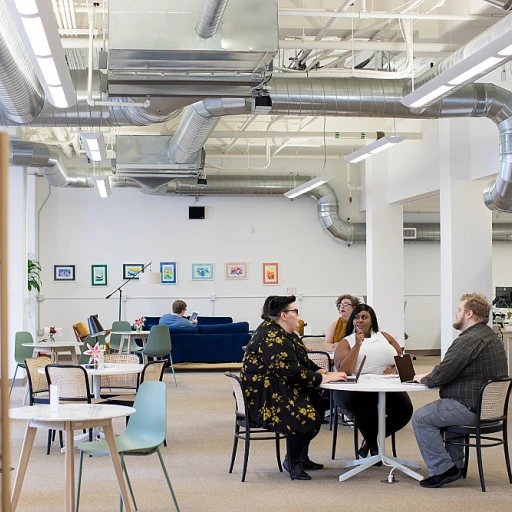Understanding the Role of a Human Capital Strategist
Deciphering the Role of a Human Capital Strategist
The realm of workforce planning stands at the intersection of various disciplines, demanding a delicate balance between art and science. At the heart of this complex landscape lies the human capital strategist. This professional, often backed by an HCS certification, holds the key to integrating talent management into the core of an organization's business strategy. Human capital management is essential in addressing organizational shifts and equipping businesses with strategic resources. A strategist must unite multiple facets - from talent acquisition to performance management - into a coherent strategy, ensuring alignment between workforce planning and overarching business objectives. In rapidly evolving business environments, organizations are met with the task of anticipating change and adapting accordingly. An effective human capital strategy must foster resilience, ensuring businesses maintain a competitive advantage in the dynamic market. By adopting a holistic approach, strategists can create robust programs that nurture employee engagement and drive performance enhancement. However, the role of a human capital strategist extends beyond mere planning. It immerses into areas involving change management and capital strategy, optimizing workforce processes to streamline organizational transformation. Harnessing human capital as a strategic asset requires a profound understanding of HCI practices, emphasizing a strategic talent outlook. Integrating insights from industry experts promotes agile workforce strategies. For further understanding, exploring innovative scheduling strategies could provide deeper insights into effective workforce planning. This ensures that organizations are not merely surviving the tides of change, but thriving with a workforce poised for future success.Identifying Workforce Challenges
Addressing Workforce Obstacles with Precision
In the ever-evolving landscape of human capital management, identifying workforce challenges is foundational for achieving business goals. Every organization is unique, and so are the hurdles it faces. Recognizing these challenges requires a strategic lens to assess aspects like workforce performance and organizational dynamics.
One common challenge is aligning talent with business strategy. This process entails understanding the skills and capabilities needed to maintain a competitive advantage. As industries evolve, matching these competencies with existing and future jobs becomes essential. A thorough analysis driven by human capital strategists can unearth potential gaps in talent management and resource utilization.
Another prevalent issue is employee engagement and retention. Organizations need to foster an environment that promotes personal and professional growth. Programs that bolster employee development and provide meaningful work effectively support this goal. This enhances overall performance management and alignment within the organization.
Identifying workforce challenges is inherently coupled with effective change management. As businesses grow and pivot, continuous assessment of workforce needs becomes crucial. Tools and methodologies for predicting needs, such as those presented in predicting employee needs for a successful future, are indispensable for ensuring a resilient operational model.
In navigating workforce obstacles, the influence of a chief human resource officer or a team of strategists can drastically improve the process. Their insights drive the strategic capital initiatives that realign the workforce with the organization’s mission. Overall, a thoughtful approach to tackling workforce challenges is a precursor to effective strategic talent acquisition and sustainable capital business growth.
Strategic Talent Acquisition
Effective Recruitment Approaches
In the dynamic landscape of business strategy, acquiring the right talent is a pivotal aspect of workforce planning. This process involves a strategic approach to talent acquisition, ensuring that the organization meets its business goals while securing a competitive advantage. A human capital strategist plays a critical role in streamlining this process by aligning it with the overall talent management strategy.Aligning with Organizational Needs
Strategic talent acquisition begins with understanding the specific needs of the organization. This requires an evaluation of the current workforce and identifying gaps in skills and competencies. By conducting thorough skills assessments and forecasts, human resource managers can align recruitment efforts with the organization's change management and performance management strategies. To minimize disruptions caused by mandatory overtime, organizations can explore effective recruitment strategies that balance workload and employee engagement.Technological Innovations in Recruitment
Leveraging technology is essential in the modern business world. Advanced human capital management systems enable organizations to streamline the recruitment process by providing deeper insights into candidate profiles, past performance, and potential future contributions. By embracing these innovations, businesses can enhance their talent acquisition strategies and maintain a resilient, adaptable workforce. The strategic involvement of a chief human resource officer or a capital strategist can further refine the recruitment process, ensuring that it not only aligns with the current human capital needs but also supports long-term organizational objectives. For organizations looking to optimize their workforce planning, developing comprehensive strategies is key to avoiding the pitfalls of ineffective recruitment.Enhancing Employee Development
Boosting Skills and Career Trajectories
In the evolving landscape of business, enhancing employee development remains a critical focus for organizations aiming to gain a competitive advantage. A well-structured development program not only aligns with business goals but also addresses workforce challenges while supporting the strategic objectives of the organization. Through effective talent management, businesses can ensure their human resources are continuously developing to meet the changing demands of their roles. This involves creating opportunities for skills enhancement, tailored training, and robust performance management systems. Integrating such strategies within the human capital framework helps in fostering a culture of continuous learning and growth. A strategic human capital management approach involves assessing current workforce capabilities and identifying potential gaps where skills may be lacking. Once these are identified, a capital strategist can design bespoke development programs that cater to the organization's needs and the individual career aspirations of employees. This aligns employee goals with business objectives, ensuring sustainable growth and adaptability in the face of change. Moreover, integrating change management practices is essential as organizations adapt to new technologies and processes. Employees equipped with the right skills and supported through developmental pathways are more likely to embrace change and drive the business forward. In essence, facilitating continuous employee development supports not only individual career growth but also enhances organizational resilience, setting the workforce on a path to success in line with strategic business objectives.Leveraging Data for Workforce Insights
Data-Driven Insights for Effective Workforce Management
In today’s dynamic business environment, leveraging data to assess workforce trends and needs is not just beneficial but essential. The implementation of a data-driven approach in managing human capital enables organizations to align their strategic goals with their talent management processes effectively. The integration of advanced analytics and Human Capital Management (HCM) solutions allows businesses to gain valuable insights into their workforce's capabilities and potential. By analyzing key performance indicators and other relevant metrics, organizations can identify skill gaps, forecast future workforce needs, and make informed, strategic decisions. Effective data utilization also enhances change management practices within an organization. By understanding employee engagement levels and performance patterns, businesses can implement targeted programs that foster a more cohesive and agile workforce. This, in turn, helps align the workforce with long-term business processes and goals, ensuring a more resilient and competitive advantage. To create a robust workforce strategy, companies must employ a diverse array of data sources. This includes internal sources, such as employee feedback and performance reviews, as well as external market data to better understand industry trends and benchmarks. By combining these data points, an organization can build comprehensive insights into their workforce dynamics. Human Capital Strategists play a pivotal role in transforming data into action. They are equipped with the expertise to interpret complex data sets and extract meaningful insights that drive workforce planning agendas. By facilitating the alignment of human resources strategies with overarching business strategies, they foster an environment where talent thrives and business goals are met. Ultimately, as organizations continue to navigate workforce challenges, leveraging data effectively remains a cornerstone of successful human capital management. It not only informs resource allocation and talent development but also strengthens the organization’s ability to adapt to evolving market conditions, ensuring sustained growth and success.Building a Resilient Workforce
Fostering a Robust Workforce Framework
Building a resilient workforce is an essential component of any successful organization. It involves not only recruiting the right talent but also ensuring that employees are engaged and prepared to adapt to changes. This requires a strategic approach to human capital management, focusing on both immediate needs and long-term business goals.
One of the key elements in developing a resilient workforce is change management. Organizations must be ready to navigate shifts in the business environment and ensure that their workforce is equipped to handle these changes. This involves creating a culture that embraces flexibility and innovation, allowing employees to thrive in dynamic conditions.
Aligning Workforce Strategy with Business Objectives
To achieve resilience, it's crucial that workforce planning aligns with the overall business strategy. This means understanding the organization's goals and ensuring that the human capital strategy supports these objectives. By doing so, businesses can maintain a competitive advantage, even in challenging times.
- Strategic Talent Management: Identifying and nurturing talent that aligns with the organization's future needs is vital. This includes developing a pipeline of potential leaders and ensuring that current employees have opportunities for growth and development.
- Performance Management: Regularly assessing employee performance and providing feedback helps maintain high standards and encourages continuous improvement. It also allows for the identification of areas where additional training or support may be needed.
- Organizational Change Programs: Implementing programs that prepare employees for organizational changes can minimize disruption and enhance resilience. This includes training sessions, workshops, and open communication channels to address concerns and provide support.
Leveraging Human Capital Insights
Data plays a crucial role in workforce planning, offering insights that can guide decision-making processes. By leveraging data analytics, organizations can better understand their workforce dynamics and identify trends that may impact future planning. This data-driven approach allows for more informed decisions regarding talent acquisition, development, and retention.
In conclusion, building a resilient workforce requires a comprehensive approach that integrates strategic talent management, change management, and data-driven insights. By aligning these elements with the organization's business strategy, companies can create a robust workforce framework capable of withstanding the challenges of today's dynamic business environment.








